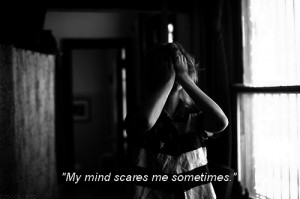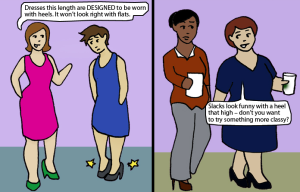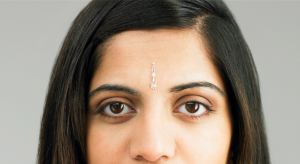
Source: Tumblr
Millennials have long been accused of being self-absorbed.
The rise of social media enables us to share our thoughts and opinions across multiple platforms within seconds. As we enter adolescence and young adulthood, we experience the typical turbulence associated with coming of age, amplified and echoed through smart phones, tweets, and reblogs.
More than ever, our generation has eagerly embraced what I like to call the “sad chic” mentality to reclaim their alienation.
Just look at popular works like The Perks of Being a Wallflower, Skins, Warm Bodies, and Twilight, to name very few.
Everyone worships existentialism as long as it has shiny packaging, with pretty people saying poetic things while a single tear runs down their cheek.
Out of all of the social media sites, Tumblr has capitalized the most on this phenomenon, almost single-handedly spawning the soft grunge trend.
Tumblr can be an excellent resource on many topics – it can change your entire perspective on gender and sexuality in a few weeks! – but I would argue that soft grunge is an unpleasant byproduct.
What is Soft Grunge?
Like the professional I am, I tried to use Urban Dictionary to come up with an exact definition of soft grunge, but all of the explanations were too heavy on sarcasm to make sense.
Coincidentally, they all also referenced Tumblr users, which leads me to believe that Tumblr might actually be the birthplace of soft grunge – or at least its breeding ground.
An example of a soft grunge blog would be a blog that features black and white images of people looking serious or melancholy, usually captioned with masochistic quotes, as well as depictions of pain and harm (like blood and bruises) that are meant to be beautiful in their tragedy.
The quotes that are used, which are often ironically unrelated to the images, promote isolation or negative feelings. Topics of choice include love, being inadequate, or wanting to die.
Soft grunge basically transforms taboo emotions like self-doubt into an aesthetic.
Feelings of worthlessness or disillusionment become synonymous with and indicative of true tortured beauty, as well as intelligence and particularly psychological depth.
Need some examples? Here you go. That’s the #softgrunge tag on Tumblr.
Soft Grunge is Okay, But the Consequences Might Not Be
As a disclaimer, I don’t mean to say that all people who enjoy soft grunge are inherently vapid or willfully scheming to hurt others. I admittedly enjoy the occasional artsy black and white photo!
Whether you’re struggling with a diagnosis or just simply trying to process through a bad day, emotional support and understanding is unfortunately hard to come by, and that camaraderie should be cherished.
Finding community can be a great thing, and I wouldn’t want to tarnish that for anyone. I’m not here to police participation.
Instead, I’m arguing for a consciousness of impact. Someone who is actively involved in any community should be aware of the potentially negative consequences of its ideology.
Certain members of the soft grunge community are propagating the style in extremely problematic ways. It’s that niche that this article is directed towards. My observations are meant to be a wake-up call for some, not a universal condemnation.
Soft Grunge and ‘Performing’ Mental Illness
People mock those who try to imitate the soft grunge lifestyle for their appropriation of music and culture without context, but the appropriation of mental illness is far more troubling.
This is where the commodification and idolization of soft grunge becomes a problem.
It’s okay to feel sad or angry or confused and express those emotions.
It’s not okay to glorify these emotions and perpetuate the idea that constantly feeling negative is somehow glamorous.
Misery doesn’t automatically equate to individuality. Being happy or even ambivalent about life does not make you boring.
You don’t have to be depressed to be beautiful or worthy of someone else’s attention. Hell, you don’t have to be beautiful, period. Beauty should not dictate your social value.
You should never publicize potentially triggering lifestyles simply as a means of self-promotion.
In fairness, you may be one of the bloggers that genuinely has a mental illness. This is directed at the kids who throw around the terms “depression” and “anxiety” every week as shiny new personality add-ons.
If you can selectively channel an emotion at will, it’s not mental illness.
You’re consciously performing a feeling for a deliberately chosen audience to make a desired impression. Genuine mental illness does not work that way.
Think of it like this: You wake up every morning and decide to put clothes on. You choose what you want – hoodie if you want to be cozy, dress and/or tie if you want to be fancy, and whatever shoes are practical or pleasing. At the end of the day, you take them off. That’s a mood, a feeling.
Now imagine that you’re forced to wear an undershirt against your will, as though it’s fused to your skin. On bad days, you despise it, and on good days, you find it annoying at best, but you can never take it off because it’s a part of you.
It doesn’t matter whether or not you want to wear it or what your environment is like or who’s around you.
Regardless of how you or anyone else feels, that fucking undershirt is there to stay, and you have to learn to live with it, even if no one else understands why it’s there. Even if you don’t want to admit that it’s there.
That’s mental illness.
How Soft Grunge Leads to Mental Illness Erasure
This is where the distinction between the soft grunge aesthetic and mental illness community becomes so crucial – because you’re marginalizing the voices and perspectives of people who really do suffer from mental illness.
Worse still, you’re arbitrarily naming yourself their poster child and advertising a candy-coated placebo as their “authentic” experience.
That so-called social anxiety that makes you so dorky and cute and lovable? There’s another person who’s locked themselves in the bathroom because the mere thought of human interaction makes them physically ill.
That picture of a beautiful actress insisting that she has no reason to live? There’s someone debating whether or not it’s worth it to wake up tomorrow.
It also doesn’t help that only impossibly gorgeous people are validated in their sadness.
We need to stop sending the message that you have to be special to be unhappy or unhappy to be special. The belief that chronic emotional instability makes you sexier or more charismatic is ridiculous.
Why would you purposely surround yourself with people who intentionally fixate on cynicism and a culture that thrives on preaching absolute worthlessness?
I’m all for critiquing society and raging against the machine, but not if it involves the asinine adolescent notion that our sense of purpose should go down the toilet if our crush doesn’t like us back.
‘Sad Chic’ Brings Others Down
When you inflame universal insecurities and turn misery into propaganda, it takes on a greater meaning beyond finding a creative outlet for your personal worries.
In effect, you are encouraging unregulated and unhealthy psychological responses because you present emotions as a pendulum and thereby trivialize moderate emotional responses as insignificant.
Soft grunge ideology makes you feel shitty about not feeling shitty enough.
You can’t be sad; you have to be depressed. You can’t be angry; you have to be on the verge of mental collapse. You can’t be bored; you have to be questioning why you exist.
Of course, everything conveniently circles back to fueling more self-doubt and hopelessness.
And you know what? That’s a really fucking terrible mentality.
Sure, growing up sucks. Responsibilities are stressful, the job market is abysmal, and your crush probably isn’t plotting to throw rocks at your window and profess their undying love. The world doesn’t have an answer to our every want and need.
We’re all human.
Things are going to make us upset and piss us off on a daily basis, but that doesn’t mean every tiny event has to cause a seismic shift in our outlook.
You feel emotions, and you move on.
I cried last week.
Why?
Because I was saddened by something that won’t matter next year, next month, or even next week. I don’t have to declare myself a lost cause forever to justify gradually processing through a feeling.
Everyone needs to allow themselves a certain flexibility of emotion to properly function in daily life.
Self-doubt and sadness are normal in small doses.
Let go of your fear of being mundane.
You can’t expect each disappointment to serve as a poetic metaphor for your psychological complexity.
Be Critical of Trends
Dealing with your moods in a healthy way might mean admitting to yourself that you’re not the next Marilyn Monroe or Kurt Cobain.
Trust me, I think we all know that those are coping mechanisms no one should strive to emulate.
Sometimes it is possible to separate style from dogma. Dye your hair pink, wear your Nirvana T-shirts and your Doc Martens, whatever. You do you.
But understand one thing: Mental illness is not a style.
Recognize the damage that trends can do to marginalized communities.
People with mental illness have a difficult enough time being heard without you claiming that you’re speaking for them.
Have a little empathy for others that isn’t driven by a personal marketing campaign. Soft grunge needs to get a little softer around the edges.
Want to discuss this further? Login to our online forum and start a post! If you’re not already registered as a forum user, please register first here.
Erin Tatum is a Contributing Writer at Everyday Feminism. She’s a feminist, queer theory lover, and television enthusiast living in Pennsylvania. She is particularly interested in examining the representation of marginalized identities in media. In addition to Everyday Feminism, she’s also a weekly contributor to Bitch Flicks. Follow her on Twitter @ErinTatum91 and read her articles here.
Search our 3000+ articles!
Read our articles about:
Our online racial justice training
Used by hundreds of universities, non-profits, and businesses.
Click to learn more




















